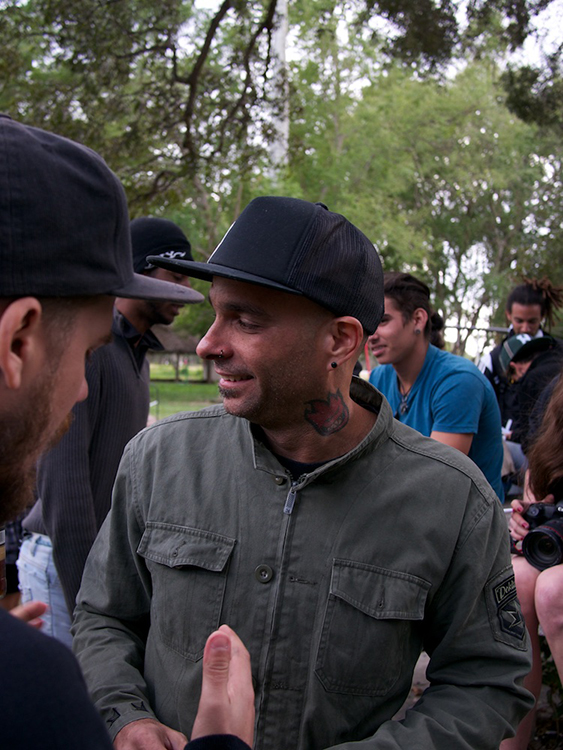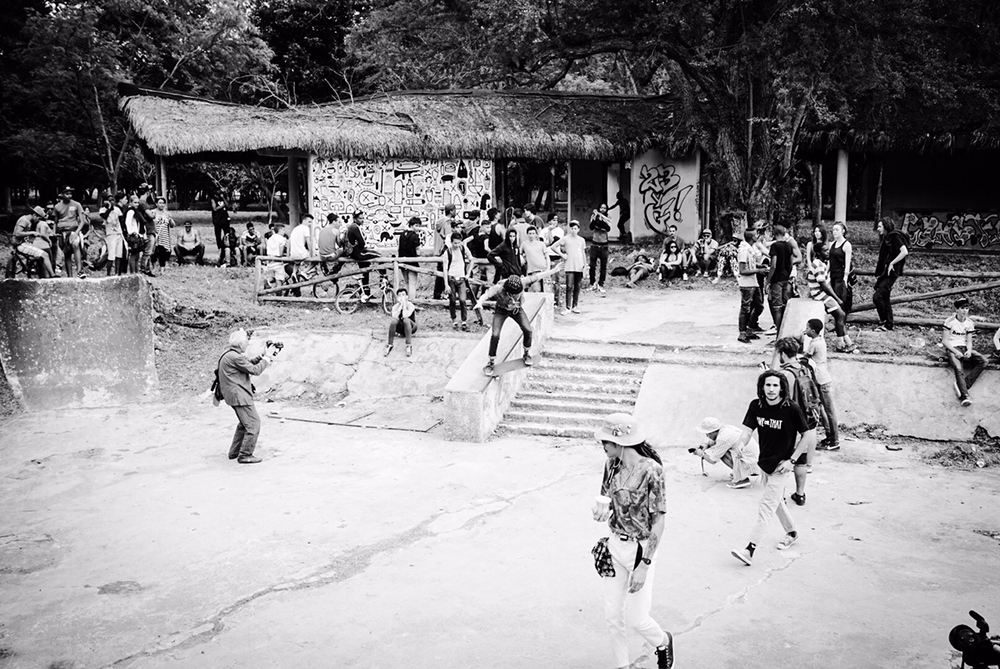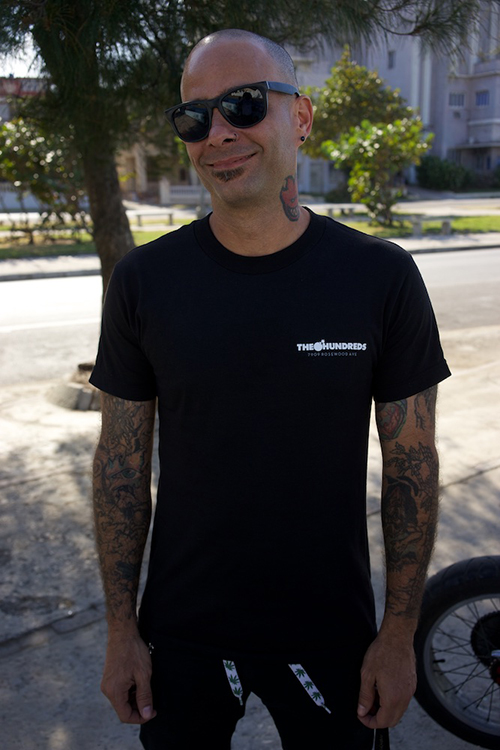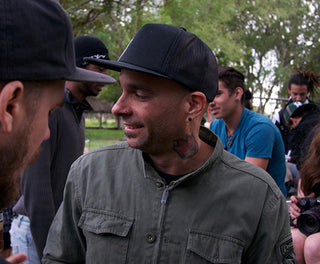It’s a struggle to write about someone that’s done more in the same amount of time as I’ve been alive. Che Alejandro Pando Napoles, or Ché for short is probably the most inspirational person I’ve met, ever. He’s done everything he’s wanted to do on his own, he wanted to skate in a country that didn’t have a skate industry – Cuba. He figured out a way to make the equipment himself, and applied the same mentality to surfing and his current profession, tattooing. All this was done with meager resources around him and through ingenuity and determination, not to mention without information readily available.
Whatever skate magazines they have in Cuba, were all brought over by friends and family. Every deck was reverse engineered and preserved to the limits. Given the nature of skateboarding, it baffles me to see how he was able to do it himself and help grow the scene there, doing things like soaking plywood in water to make it flexible enough to press into a makeshift deck.
He runs, for lack of a better word, a skateshop, where he doesn’t charge kids for products. He hands it out to those who skate and aren’t trying to profit on the equipment that’s been donated. Spending time with him while I was in Cuba reminded me why I started skateboarding, and the release it’s given me, and the doors it’s opened in my life. Most of the things I do in life are directly connected to my skateboarding and the people I’ve met. All this being said, he’ll be the first to say he isn’t a leader or wants responsibility for anything – he’s just doing it out of the love of skateboarding and what it’s given him.

PETE PABON: How were you introduced to skateboarding?
CHE: I was introduced to skateboarding at an early age, maybe 7 or 8, and watched some kids skating down the block going downhill, and that’s how it started. That was in the ’80s, the early ’80s.
How did you come about getting equipment back then, when you started?
Back then, there was no equipment. Still [to this day], there is no skate shop you can go and buy the stuff you need, so the way we skated was like the 1970s, ’60s, and ’50s in California – steel wheels from a roller-skates. We split them apart and screw it into a piece of wood. That’s how we started and we skated a long time that way.
You mentioned that you were a carpenter, and made your own decks. You’d soak them in water so you were able to warp them and try and shape them?
In the ’90s, I became a carpenter and it was available to me to steal some plywood from my workplace, so I started to make my own skateboards. I would soak them in water for a day so the glue [began] to liquefy a little bit, and you could press it in hand-made presses that we had.
We did the concave, the tail, and everything. Santa Cruz then came out with the Everslick boards, so we started putting plastic epoxy-resin on the bottom so you could slide better and last longer.
You said that also that your friend would bring back urethane from tanks, and you guys would cut them and have them shaped into wheels.
Yes, [we would have a machinist do it].
And he’d make the wheels for you?
Yes, we’d make everything. We make everything.
…Back in the ’90s, it was more of a “make it yourself” mentality, because there was nothing available to you, so the way we make our trucks is we had contacts in a bus factory, and they’d make this mold, and they would pour liquefied aluminum, and we’d put in the bolts/screws. For the wheels, we’d use urethane from tanks and we’d send them to machinist so they can make the shape of the wheel for us and we skated like that for a long time. With surfboards we did the surfboards too, everything you need to do you’d do it like that.

The skate contest Amigo Skate held in Havana from a previous story.
Do it yourself?
Yes, do it yourself. There is a Russian model for fish stores – they had these pre-made walls with aluminum and foam in the middle. When they started to slip them apart to build new place, we asked for the walls. We’d strip the aluminum and saved the the bigger pieces of foam, and we took that foam and we’d buy some epoxy resin from a place that makes plastic boats illegally, because someone stole it and sold it to you, and that way we made our surfboards and I made the fins from plywood and we coated it in epoxy-resin so it’ll last longer. We shaped it, we sand it, we paint it. Everything you had to do, you’d do it like that.
That’s amazing. You now help skateboarding flourish here in Havana by helping skaters get equipment, can you talk about that?
Yeah, since I’ve been skating for so long, I tried to help with contests and people coming over to try and direct them to the right person to organize contests and give away donations that people bring. I never claimed to be a boss or anything, I’m just a skater that likes to help people, and I’d like to see the sport get to another level. Still to [this day], it’s hard to get equipment, so thank you so much for you guys doing this for us.
“NOBODY KNEW HOW TO MAKE A [TATTOO] MACHINE – SO YOU TRY AND FIND OUT A WAY TO MAKE IT.”
You’ve also applied that same do it yourself mentality to your profession as a tattoo artist. Can you touch on that?
Yeah, when tattooing started to become more popular in the early ’90s, it was hand poking, with China ink, needle and thread. Nobody knew how to make a machine – so you try and find out a way to make it. The way we did it was the same way Californians did it in the joint, start to make their own machines with a cassette motor and sewing needles attached with thread. Stuff like that. Our friends made machines and that’s how it develops and keeps developing.
What did you guys use for ink? India ink? Black line art?
Yeah, Chinese ink. We had 5 colors, a Chinese ink made in the Czech Republic, I don’t remember the brand. It was for pens. It was safe. All the tattoo artists have spots of ink, because we all tried inks on ourselves before we tried it on a customer, you know?

You also store equipment for the kids here to and don’t charge them, and help them maintain their equipment.
People bring donations. I’m not allowed legally to accept donations, because I am not working for the government. I’m just a skater-slash-tattoo artist – that’s what I am. I’m nobody.
Well, what I do is stash stuff away and I start to give it away. You bring your broken board, you have to land a trick in front of me, then I’ll give you a new board, bearings, or whatever you need. Because that’s not mine, thats their stuff.
…Out of the love you have for skateboarding, you’re not trying to be a leader or anything – you’re basically a skater and this is what you love to do and you want to see the other kids do it as well.
Of course, thats what I’m trying to do. Skateboarding is such a wonderful thing.


